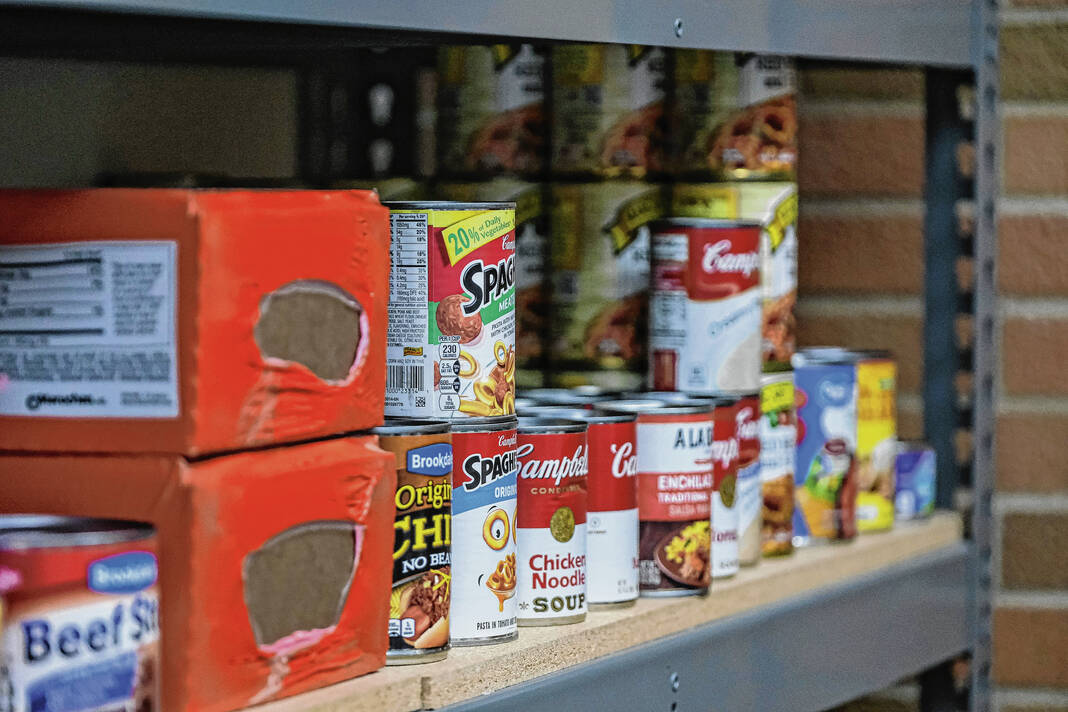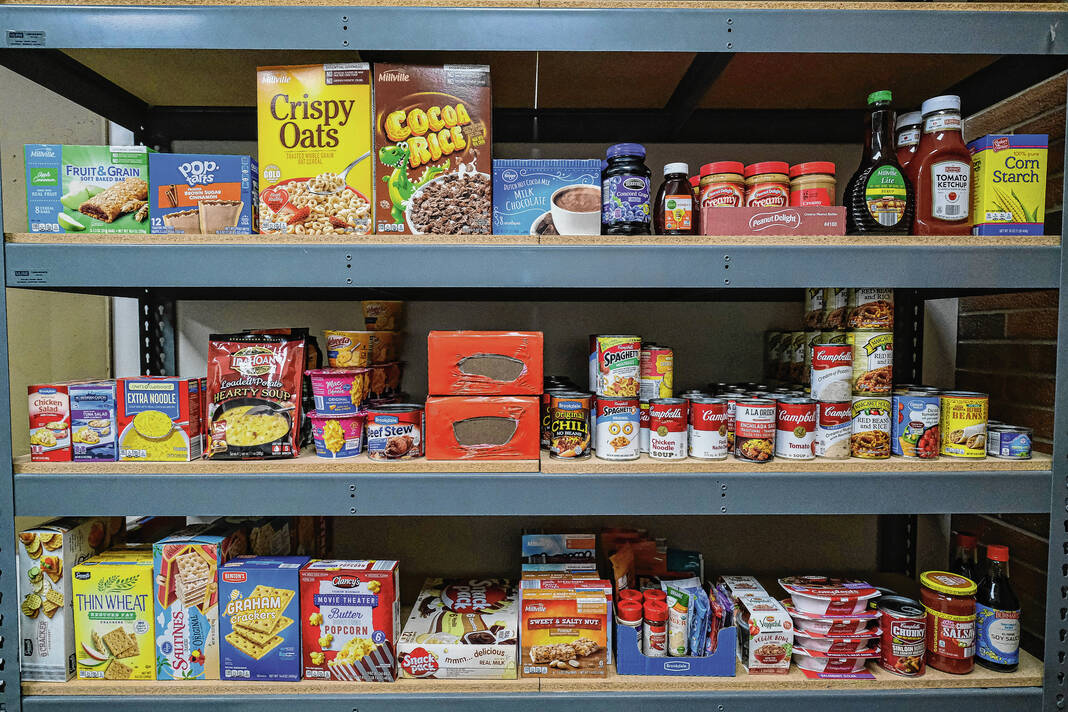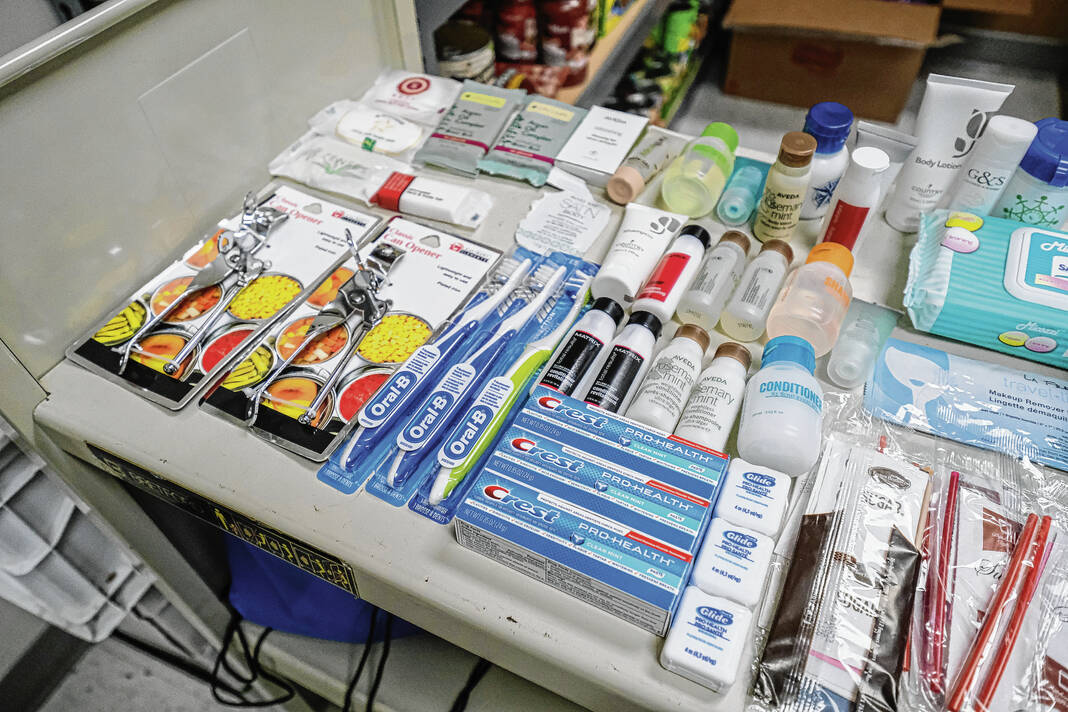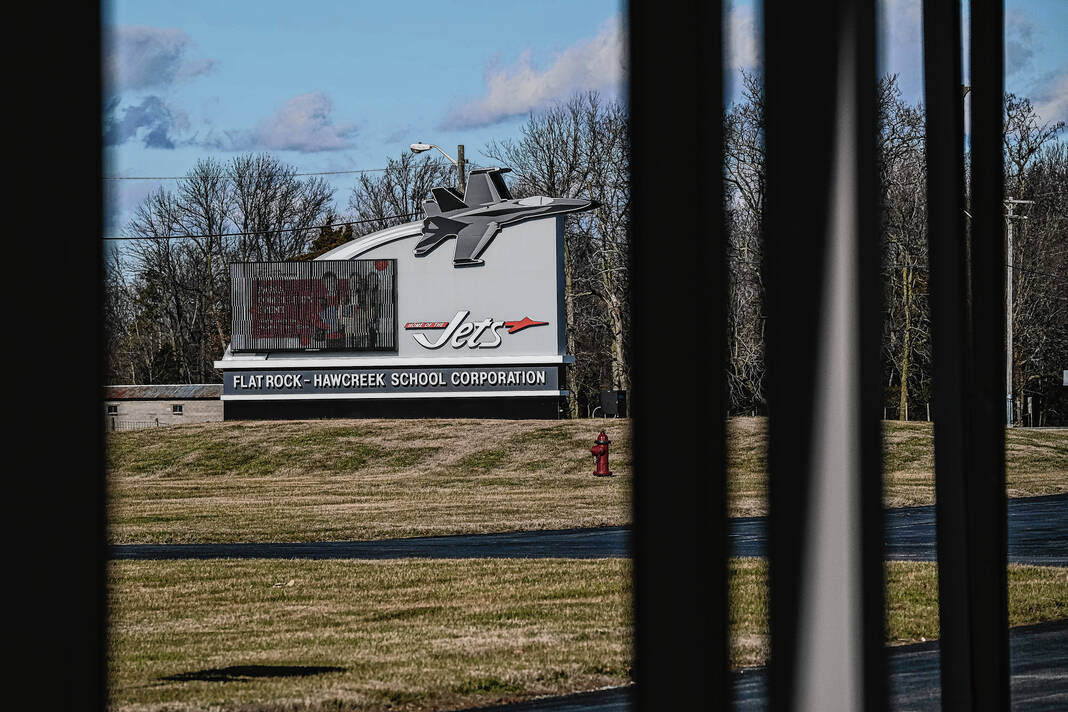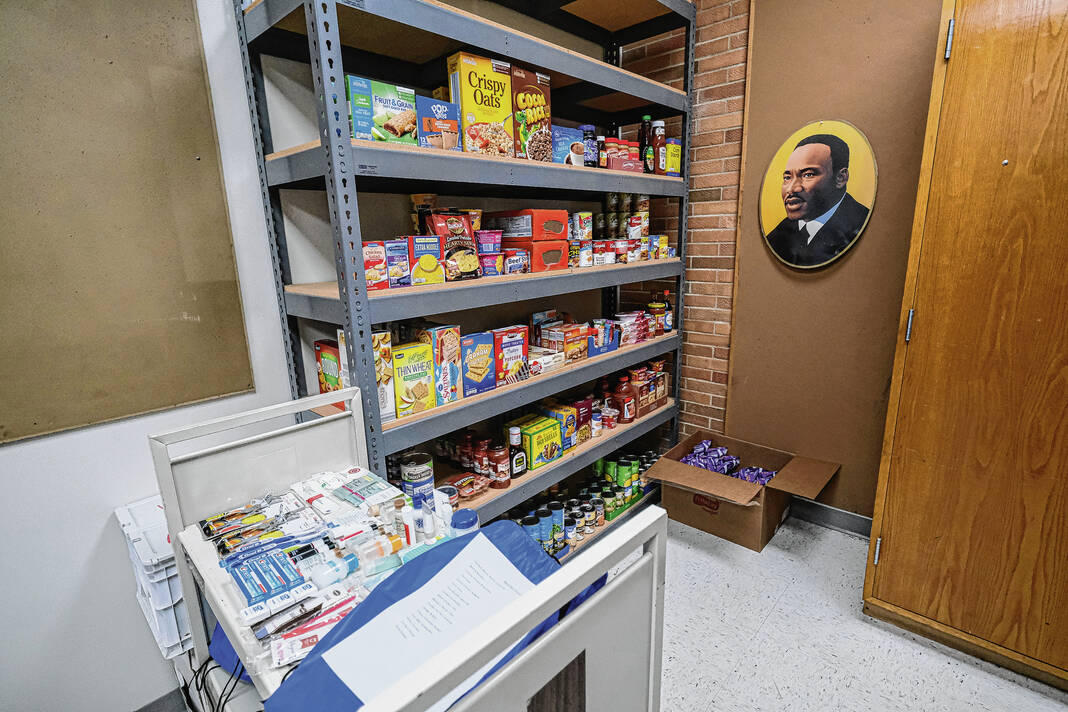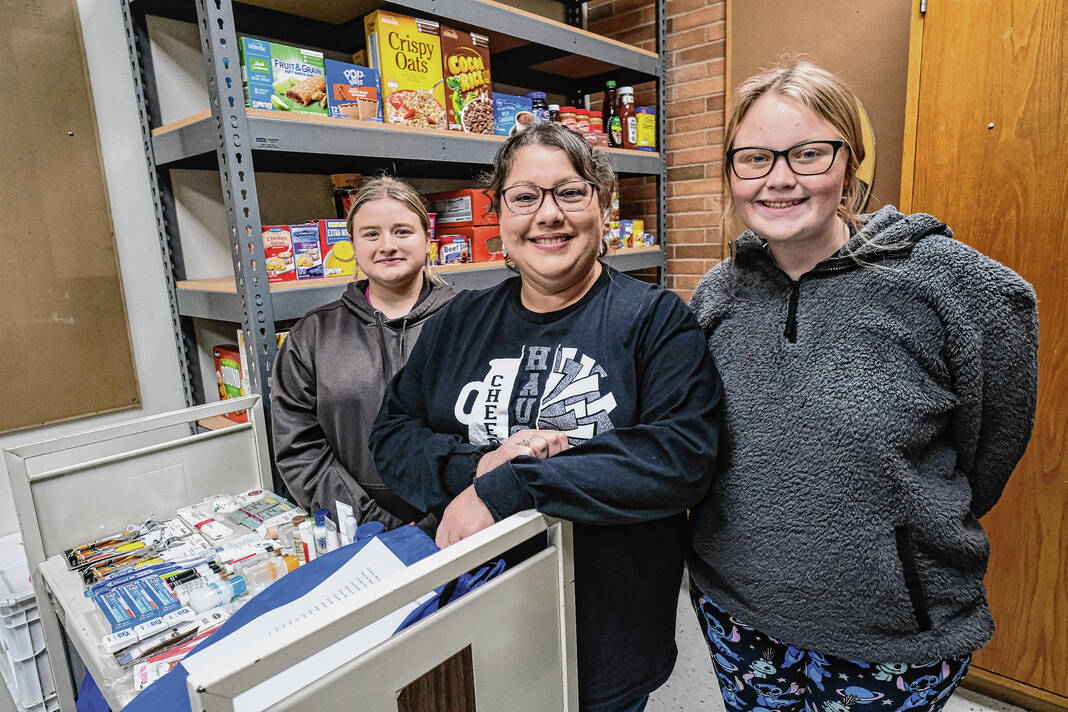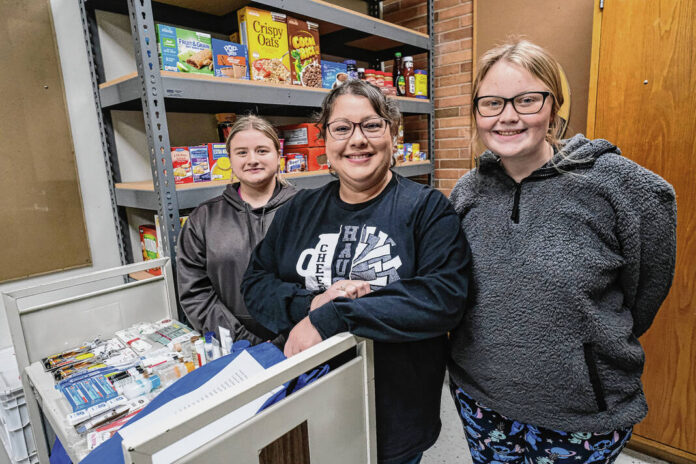
Mike Wolanin | The Republic Hauser librarian Sharri Hamilton, center, poses with students Kiley Capes, left, and Lydia Jordan pose for a photo in the food bank inside the library at Hauser Jr./Sr. High School in Hope, Ind.. Tuesday, Jan. 17, 2023.
Coordinators for local school’s food pantries are concerned that their distribution numbers indicate some students who could use the help are not receiving food because of concerns about the stigma.
The Indiana Department of Education (IDOE) classifies about 46% of Bartholomew Consolidated School Corp. students as eligible for free or reduced meals — 5,344 out of 11,635. For the Flat Rock Hawcreek School Corp., the rate is almost 50%, or 481 out of 972 students.
And yet, local schools’ food pantries aren’t seeing a level of use that reflects these numbers — or the fact that, as of December, food prices had increased 10% over the past year, according to the U.S. Bureau of Labor Statistics.
During the first semester of the 2022-23 school year, Columbus North’s Bull Dog Pantry saw about 80 to 100 families at each distribution event, which was down from pre-COVID, said art teacher and pantry coordinator Tonya Cruser.
“We got to where we almost were not necessarily having to turn people away, but … the shelves were getting really bare by the end of each distribution that we had,” she said. “And then when COVID hit, they had us close completely.”
The pantry reopened at the beginning of the 2021-22 school year, with Cruser saying that she believes it was limited to only Columbus North families initially. It has since moved to serving all BCSC families once again.
Their numbers were sparse at first but have started to pick up some, said Cruser. She said it could be an issue of communication.
However, when she posted about the pantry’s ready-to-cook Thanksgiving dinners, which were available to 120 families, orders filled up in less than 24 hours.
“So I know the word is getting out, but I just don’t know what’s preventing people from coming,” she said. “I don’t think that the demand has gone down, by any means, since grocery prices are higher … everything is higher. So I don’t know. We are just kind of stumped.”
Cruser is also aware of the district-level need, having recently led a social media fundraiser to pay off all BCSC lunch accounts with a negative balance. She met her goal and raised just under $6,000 — about twice as much as it cost to cover students debts in 2019, by her estimates.
She’s also heard from students who said they didn’t have food all weekend because there was nothing to eat at home.
At North, 858 out of 2,224 students — or about 39% — are categorized as eligible for free and reduced meals by IDOE. State officials said in a previous interview that this category includes all students who have applied and been approved to receive free or reduced benefits, as well as those who are automatically eligible.
Columbus East has a similar rate, with about 593 of the school’s 1,535 students included in this category.
Like North, East has a food pantry, which is open to BCSC students and families and primarily used by those at the school, said special education teacher Suzanne Romanski. She and two other teachers work to coordinate the pantry, which is used by about 40 to 50 students each month. This is actually more students than in previous years, but “not nearly as many as we feel should be using us,” said Romanski.
At Hauser Jr.-Sr. High School, the school’s food bank is still relatively new, having opened after the 2022 fall break. It is coordinated by district librarian Sharri Hamilton and teacher Melissa Newcomb. The two women sponsor the school’s Key Club and Horizons Club, respectively. The two clubs partnered to start the food bank, which also received a grant from the Students’ Fund of Hope.
The state classifies about 45% of Hauser students as eligible for free and reduced meals — 200 out of 444. Hamilton estimated that about a dozen students use the pantry each month, with Newcomb adding that each grade level is made up of about 60 to 80 students.
“We’re a very small school,” said Newcomb. “So I love that we’re serving that many, because it tells me that we’ve got kids that are, number one, feeling safe and secure using it, and number two, that we’ve got some significant amount that are coming and using it. This tells me there was a little bit of a need there.”
Still, the perception that comes with asking for help can be a barrier for many students, according to pantry coordinators.
“One of the biggest challenges is getting kids to access the pantry,” said Cruser. “There’s a stigma around that; they don’t want to be seen by their peers. … There are still some who will come, regardless of who sees them, they’ll come get the stuff. If they need it, they’ll get it. And there are others who, I think, have never told their parents that the pantry exists.”
She added that kids and parents can contact her directly to arrange pickup if they are unable to attend a distribution event or are seeking privacy.
In regards to Hauser’s food bank, Newcomb said it is located inside a smaller room within the library where Hamilton also sells snacks, so this provides a good cover.
“Sharri’s done such an amazing job with the meal kits, because she’s got the recipe card in there, and then she has it all packaged in a nice, little, nondescript, discreet, bag that the kids can grab and either just carry or stuff in the backpack,” said Newcomb. “So you know, the big thing with any high school food bank is to try to make sure it’s very discreet so kids are able to come and go without having suspicion arisen that they have gone in there.”
Romanski said that stigma is an issue for East’s food pantry as well and that given the number of students on free and reduced meals, the pantry should be seeing more users.
“Another problem with the pantry, which I think is a very significant issue, is getting the food home,” she added, “because with their backpacks and carrying bags of food, it’s cumbersome. Plus, I think it might be embarrassing for kids who ride the bus.”
They’ve tried to work around this by putting food in boxes for some students so that no one can see what they’re carrying. For others, their families pick up the food during the day or after school. There are also some students who pick up small portions — small enough to fit in their backpack — a few days in a row.
Another challenge is that East’s pantry is in a transition period. Greg Lewis, who previously ran the pantry, retired from teaching at the end of the 2021-22 school year and is now a school bus driver for BCSC, said Romanski. He is still somewhat involved with the effort and helps by ordering food each month and unloading it. He is also working with a senior project student to stock shelves and monitor what items go in and out.
“He’s doing his best to support the pantry from the outside,” said Romanski.
Still, the change in leadership has led to some difficulties, with multiple teachers having to fit the pantry into their busy schedules and take turns running it.
As a department chair, Lewis didn’t have a full class load and had more time to spend on the pantry, said Romanski. Even then, it was still a very time-consuming cause that would also take up his evenings and weekends.
“When we were open to the community, we all felt it was such a valuable resource for the community, but again, it took so many manpower hours, and he would have to ask for all these volunteers to bag the groceries,” she said. “And we would usually get enough kids to help us distribute it and staff, but not always. Sometimes there would just be three or four of us out there, distributing to almost 200 cars. And just, unfortunately, was not sustainable. But clearly there’s a need.”

